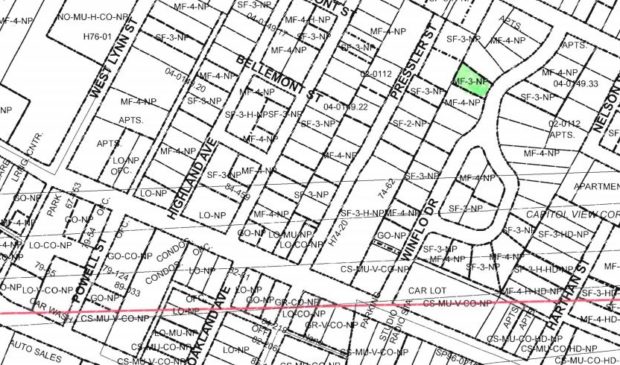West Austin Triplex bid stalls at BoA
Wednesday, June 14, 2017 by
Elizabeth Pagano Time and money did not prove to be a sufficient hardship at the Board of Adjustment, where an Old West Austin homeowner hoping to build a triplex on a multifamily lot learned the price of 600 feet this week.
William Schaub explained that he hoped to build three residential units on his property at 804 Winflo Drive. The plan, he said, was to occupy one of the units with his wife and have their son, who has Down syndrome, occupy another unit on the property. The third unit would be rented out. That would be allowed if the lot was 8,000 square feet, but it is only 7,353 square feet, so he was seeking a variance from the city.
Board of Adjustment members voted to deny the variance in a vote of 7-4, with Board members Eric Goff, Rahm McDaniel, Veronica Rivera and Michael Von Ohlen voting in opposition.
Schaub told the board that he had hired a developer, a civil engineer and an architect. Then, he said, “A hundred-and-some thousand dollars later, I have a site plan that is 18 months old.”
“We met with the city four or five times,” he continued. “We have gone through a long process trying to follow the rules and do everything right.” He said that he was informed that the lot was not big enough “late last year” which was well into the development process.
Schaub said that he respected the neighbors that opposed his variance request and told the board he had tried to meet with everyone to talk over the plan. “They didn’t say it wasn’t nice,” he said. “They were concerned about the precedent.”
Rosemary Merriam, chair of the Old West Austin Neighborhood Association Zoning Committee, apologized to the property owners, but explained the group had voted to oppose the variance at OWANA’s zoning, steering and membership meetings.
Chris Schorre, who is also a neighbor, confirmed this opposition. He said that the neighborhood was opposing development on undersized lots in general, which could set a precedent.
Though the lot is zoned for multifamily use, Schorre said that there are 340 parcels in the neighborhood that are zoned multifamily but currently in use as single family. He cited their neighborhood plan, which states that multifamily zoning “presents a continued threat to single-family uses.”
“Minimum lot sizes are really intended to preserve greenery and to preserve the character of the neighborhood,” said Schorre. He told the board that intense impervious cover negatively impacted flooding and the “heat island” effect in the neighborhood. He explained that CodeNEXT has assigned T4N.IS zoning, which allows a maximum impervious cover of 45 percent, to “almost all of our neighborhood” instead of the allowed 65 percent for MF-3 zoning.
Schaub’s agent, Mike McHone, argued that the lot was platted in 1946, and the substandard lot would have been grandfathered if it were a single-family zoning instead of a multifamily one. He also tried to explain that if the lot lines were straight, instead of curved, the lot would be a standard size and not need a variance.
As for CodeNEXT, Schaub asked the board to disregard that for now. “My understanding is that is in draft form and hopefully that’s not something you would base a decision on here tonight,” he said. “It certainly wasn’t anything we had the benefit of knowing about from a planning standpoint.”
Chair William Burkhardt observed that the zoning in the neighborhood was “chaotic at best.” After some debate about the history and future of zoning in the neighborhood, and the shape of the lots, McDaniel stepped in.
“Irrespective of whether it was zoned ‘A’ or ‘B’ in 1948, it is zoned multifamily now. … And just in terms of the character of the neighborhood, this is a vacant lot zoned multifamily, across the street from multifamily, next door to multifamily,” said McDaniel. “For me this comes down to whether or not you are being denied a reasonable use of a property, which is already zoned multifamily, simply because it is substandard by 600 feet and has been subjected to a zoning change at some point.”
Von Ohlen said he “had a problem” with the fact that the plans had already been approved by the city, leading to a “substantial” investment by the homeowner, “only to be told, ‘Psych! It’s not going to happen.’”
On the other hand, Board Member Brooke Bailey brought up the point that it was a vacant lot and argued that building a duplex – which would be allowed without a variance – was a reasonable use of the property. “I don’t see a hardship. It’s more of a desire to build a triplex than a hardship for me,” she said.
Burkhardt said he appreciated that Schaub had spent a lot of money and possibly been misled, but he could not support the variance.
The Austin Monitor’s work is made possible by donations from the community. Though our reporting covers donors from time to time, we are careful to keep business and editorial efforts separate while maintaining transparency. A complete list of donors is available here, and our code of ethics is explained here.
You're a community leader
And we’re honored you look to us for serious, in-depth news. You know a strong community needs local and dedicated watchdog reporting. We’re here for you and that won’t change. Now will you take the powerful next step and support our nonprofit news organization?








